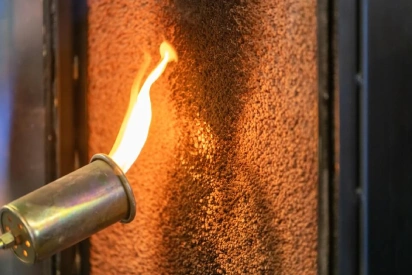Advanced Fire-Resistant Materials: Innovations in Combating Wildfires
New Heaven Developers June 18, 2025

Understanding the Wildfire Threat in Our Regions
Wildfires have become increasingly frequent and severe in California and other wildfire-prone regions. Our communities in Altadena and Palisades face unique challenges due to dense vegetation, dry conditions, and sometimes difficult terrain that can accelerate fire spread. Traditional building materials, while effective under many conditions, often fall short when exposed to intense wildfire heat and embers. We understand that protecting a home from wildfire damage goes beyond just defensible space and landscaping—it starts with the very materials used in construction.What Are Fire-Resistant Materials?
Fire-resistant materials are specially designed to withstand exposure to flames and extreme heat without igniting, melting, or losing structural integrity. Unlike fireproof materials—which do not exist in a true sense—fire-resistant materials delay or reduce the spread of fire, providing critical time for occupants to evacuate and for firefighters to respond. Our team focuses on integrating these materials into rebuilding projects, ensuring homes are better prepared against wildfire risks.Innovations in Fire-Resistant Building Materials
The last decade has witnessed significant advances in fire-resistant technology. Below are some key innovations that we utilize and recommend:- 1. Fire-Resistant Siding and CladdingSiding materials traditionally used in homes—such as vinyl or untreated wood—can ignite quickly under wildfire conditions. New fire-resistant siding options include:
- Fiber Cement Board: Made from a mix of cement, sand, and cellulose fibers, fiber cement is non-combustible and can withstand high temperatures without deforming. It is widely used due to its durability and fire resistance.
- Fire-Retardant Treated Wood: Some wood products are chemically treated to reduce flammability. These treatments slow ignition and flame spread, although they still require proper maintenance.
- Metal Siding: Metals like aluminum and steel provide excellent fire resistance as they do not combust, though they can conduct heat.
- 2. Fire-Resistant Roofing MaterialsRoofs are particularly vulnerable during wildfires because of their large surface area and potential to catch airborne embers.
- Class A Roofing Materials: These include fire-resistant asphalt shingles, metal roofing, clay tiles, and concrete tiles. Class A is the highest fire rating available for roofing materials and is essential in wildfire-prone areas.
- Intumescent Coatings: These coatings swell and form a protective char layer when exposed to heat, protecting roofing materials beneath them.
- 3. Fire-Resistant Windows and GlassWindows often become a weak link during a wildfire, with heat causing glass to shatter and allowing embers inside.
- Tempered and Laminated Glass: These types of glass resist heat better than standard panes. Laminated glass contains a plastic interlayer that holds glass fragments together if broken.
- Fire-Resistant Window Frames: Materials such as metal or fiberglass frames outperform wood and vinyl in resisting fire.
- 4. Fire-Retardant Coatings and PaintsBeyond structural materials, fire-retardant coatings can be applied to surfaces to enhance resistance.
- Intumescent Paints: When exposed to heat, these paints expand to create an insulating barrier that protects the underlying material from flames.
- Fire-Resistant Sealants: Used in gaps and joints, these sealants prevent embers and flames from penetrating vulnerable points.
- 5. Insulation MaterialsInsulation plays a role not only in energy efficiency but also in fire resistance.
- Mineral Wool Insulation: Made from rock or slag, mineral wool is non-combustible and can withstand high temperatures.
- Fire-Resistant Foam Insulation: Some spray foams are formulated with fire retardants, though careful selection is critical to meet safety standards.
How Advanced Materials Protect Structures and Occupants
Incorporating these advanced materials into construction significantly reduces the likelihood of ignition and structural failure during a wildfire. When homes use non-combustible sidings and roofing combined with fire-resistant windows and coatings, the building envelope forms a robust barrier against flames and embers. This barrier:- Prevents Embers from Entering: Embers can ignite flammable materials inside homes. Fire-resistant windows, sealants, and vents minimize ember intrusion.
- Maintains Structural Integrity: Fire-resistant materials resist charring and warping, helping the structure stand firm even when exposed to intense heat.
- Slows Fire Spread: By reducing combustible surfaces, the fire’s progress slows, allowing more time for evacuation and firefighting efforts.
Building Codes and Standards Guiding Fire-Resistant Construction
New Haven Developers ensures that every project complies with the latest local and national fire safety regulations. Some relevant codes and standards include:- California Building Code (CBC) Chapter 7A: This chapter specifically addresses materials and construction methods for exterior wildfire exposure.
- Wildland-Urban Interface (WUI) Codes: These guidelines apply to homes in areas where wildfires meet developed land, prescribing fire-resistant materials and design.
- National Fire Protection Association (NFPA) 1144: Standard for reducing structure ignition hazards from wildland fire.
Challenges in Using Advanced Fire-Resistant Materials
While these materials offer improved safety, there are challenges that New Haven Developers carefully manage:- Cost Considerations: Fire-resistant materials may carry higher upfront costs. However, the investment often pays off by reducing long-term repair costs and increasing property value.
- Aesthetic Preferences: Some homeowners prefer the look of traditional materials. We work closely with clients to balance aesthetics and safety, sometimes using fire-resistant treatments that maintain the desired appearance.
- Maintenance: Some fire-resistant materials and coatings require periodic inspection and upkeep to maintain effectiveness.
